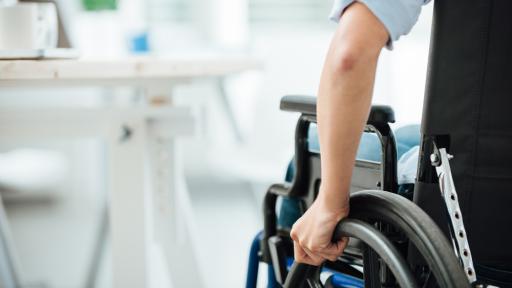Pressure ulcers are areas of damaged skin caused by pressure or friction. They are also known as pressure sores, bedsores or decubitus ulcers.
Pressure ulcers develop when part of your body is compressed for a long period, and the blood supply to a region of your skin is cut off. If you usually remain seated, in a wheelchair, for example, you might develop pressure ulcers on the buttocks, back of the thighs or back.
You may be at risk of pressure ulcers if your MS means that you have reduced mobility, poor nutrition or posture, neurological damage affecting your skin, or if you are obese or underweight. Pressure ulcers are most likely to occur in places where your bones are near the skin, such as the pelvic bone in your buttocks.
1. Change position regularly
To prevent pressure ulcers developing, try to reduce the pressure on the vulnerable parts of your body. Making a slight alteration to your position every 20 minutes during the day will help to prevent skin damage. If you are seated this could take the form of rolling slightly from cheek to cheek in the chair. You could set a timer to remind you or a carer to help you change position.
2. Use the right equipment
Your MS Nurse, District Nurse or an occupational therapist can advise you on suitable equipment to reduce the risk of pressure ulcers. These include your bed, armchair, wheelchair, car seat, office chairs, cushions and mattresses. They can also supply equipment to use when on holiday, at hospital or away from home for any reason.
Avoid any form of ring cushion as they can squeeze the blood vessels in your skin and cause pressure damage.
3. Eat a nutritious diet
Eat a well balanced diet, to ensure that you are not short of any essential nutrients. Your skin needs nutrients to keep it health, and even a short period of not eating well increases the risk of skin damage. A nutritious diet is particularly important if you are unwell with flu, for example.
4. Keep your skin clean and dry
You are more at risk of pressure ulcers if your skin is sweaty, swollen or broken, so it's important to make sure your skin remains clean and dry. You or a carer should check for damaged areas on your skin every day. On dark skin a pressure ulcer could look purple or blue, and on pale skin it could look red. Reddened areas should fade within minutes when pressure is relieved. If they do not, seek advice from a district nurse.
5. Transfer safely
Moving from wheelchair to chair or bed can cause pressure damage. Make sure you know how to transfer yourself safely without sliding or dragging on your skin, and that you are using lifting equipment correctly. If you have a carer, ensure that they understand the importance of protecting your skin and supporting you to transfer from place to place safely. Avoid sliding and pushing when this may result in tugging or friction on the skin.
6. Be aware of good posture
Learn the correct positioning for your body, and get the right support in place. This will improve your comfort and avoid pressure building up, particularly when you are seated. An occupational therapist can advise you on the right way to position yourself and can supply the right equipment to help. Our information on posture may be useful.
If you think that you or someone you care for has a pressure ulcer, tell a qualified health professional. It is unlikely to heal on its own. Your MS nurse, GP or district nurse may refer you to a tissue viability nurse who will monitor and treat the pressure ulcer.
Treatment can take weeks or months, depending on how severe the pressure ulcer has become. Very severe pressure ulcers may need surgery to seal the wound. Otherwise treatment involves keeping the area clean, dry and with an appropriate dressing. A tissue viability nurse or district nurse may be able to visit your home to do this. They can use special dressings that help encourage the growth of new skin and speed up the healing process.
The nurse will also be able to recommend a nutritious diet, cushioning equipment and strategies for safe positioning and moving to avoid making the pressure ulcer worse.
Antibiotics might be prescribed if the ulcer becomes infected. If infection spreads from an infected pressure ulcer it could have serious complications including blood poisoning.


